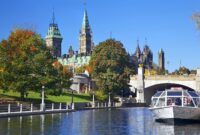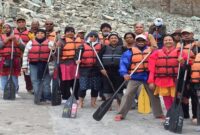Senior Citizen Group Tours offer a unique blend of adventure, companionship, and relaxation, catering to the specific needs and desires of older travelers. These tours are designed to provide enriching experiences while mitigating common travel anxieties often associated with aging. From meticulously planned itineraries to accessible accommodations and expert guidance, group travel opens up a world of possibilities for seniors, allowing them to explore new cultures, revisit cherished destinations, or simply enjoy quality time with like-minded individuals.
This guide delves into the various aspects of senior citizen group tours, examining the market demographics, diverse tour types, logistical considerations, effective marketing strategies, and the crucial importance of accessibility and inclusivity. We’ll explore how tour operators can successfully cater to the unique needs of this demographic, creating memorable and fulfilling travel experiences for all participants. The goal is to provide a comprehensive understanding of this growing sector of the travel industry.
Success Factors and Challenges in Senior Citizen Group Tours
Successfully organizing senior citizen group tours requires careful planning and execution, considering the unique needs and preferences of this demographic. A well-structured tour balances engaging activities with comfortable pacing and ample opportunities for rest and relaxation. Conversely, poorly planned tours can lead to dissatisfaction and negative experiences. Understanding the factors contributing to both success and failure is crucial for tour operators.
Successful senior citizen group tours prioritize accessibility, comfort, and engaging, yet manageable itineraries. They often feature slower paces, shorter travel times between destinations, and ample time for rest and relaxation. Unsuccessful tours, on the other hand, might involve overly ambitious itineraries, inadequate consideration for mobility limitations, or a lack of personalized attention to individual needs. For instance, a successful tour might include a leisurely walking tour of a historical site with frequent rest stops and the option to use a wheelchair or mobility scooter, while an unsuccessful tour might involve extensive walking tours with little consideration for physical limitations.
Successful Tour Examples and Characteristics
Successful senior citizen group tours often share several key characteristics. They prioritize clear and concise communication, providing detailed itineraries and readily available contact information for support. Tours typically incorporate accessible transportation, suitable accommodation with appropriate amenities (e.g., elevators, grab bars), and activities tailored to the physical capabilities and interests of the participants. For example, a successful tour to a national park might offer the option of a guided bus tour alongside shorter walking trails, ensuring everyone can participate at their own pace. Another example is a cruise focusing on slower paced port visits and easily accessible onboard amenities. These tours often benefit from pre-trip briefings and regular communication updates, building anticipation and addressing any concerns.
Challenges Faced by Tour Operators
Organizing senior citizen group tours presents several unique challenges. Managing diverse health needs and physical limitations requires careful planning and flexibility. Unexpected medical emergencies or changes in participants’ mobility can disrupt itineraries and necessitate quick problem-solving. Addressing individual preferences and dietary restrictions also requires significant coordination and attention to detail. Furthermore, communication can be challenging, particularly with participants who have hearing or visual impairments. Finally, managing expectations and addressing potential complaints requires proactive communication and a willingness to adapt to changing circumstances.
Solutions for Addressing Challenges
Several strategies can mitigate the challenges associated with senior citizen group tours. Comprehensive pre-trip questionnaires can gather vital information about participants’ health, mobility, and dietary needs. This information enables tour operators to customize itineraries and make appropriate arrangements. Having a designated point of contact readily available throughout the tour provides a crucial support system for participants. Including backup plans for transportation and activities ensures flexibility in case of unforeseen circumstances, such as inclement weather or medical emergencies. Regular check-ins with participants allow for early identification and resolution of potential problems, and providing clear communication channels helps manage expectations and address complaints effectively. For instance, having a dedicated medical professional accompanying the group or readily accessible emergency medical services can alleviate concerns related to health emergencies. Providing options for various levels of physical activity ensures everyone can participate at their comfort level.
Ultimate Conclusion
Ultimately, the success of senior citizen group tours hinges on a careful balance of meticulous planning, attentive service, and a genuine understanding of the senior traveler’s needs and desires. By prioritizing accessibility, inclusivity, and personalized experiences, tour operators can create unforgettable journeys that enrich the lives of their clients and foster a thriving community of seasoned explorers. The future of senior travel is bright, promising a wealth of opportunities for exploration and connection for years to come. Careful consideration of the factors outlined in this guide will ensure the continued growth and success of this vital segment of the tourism industry.




